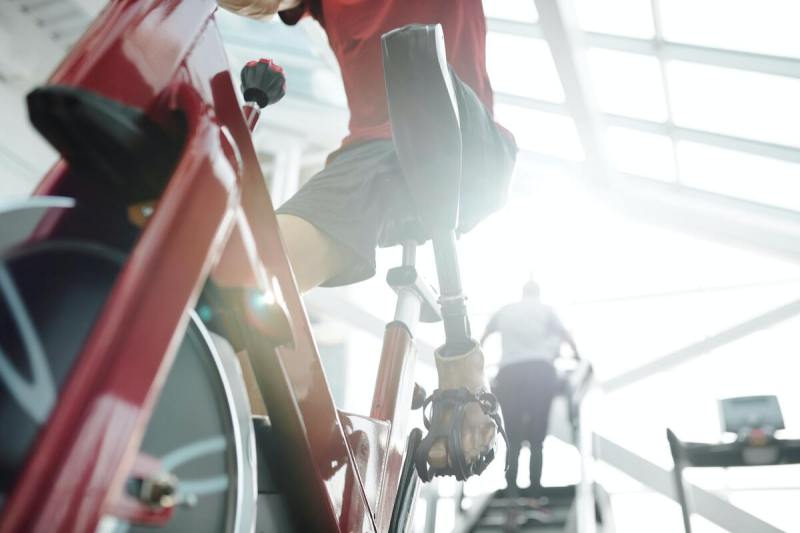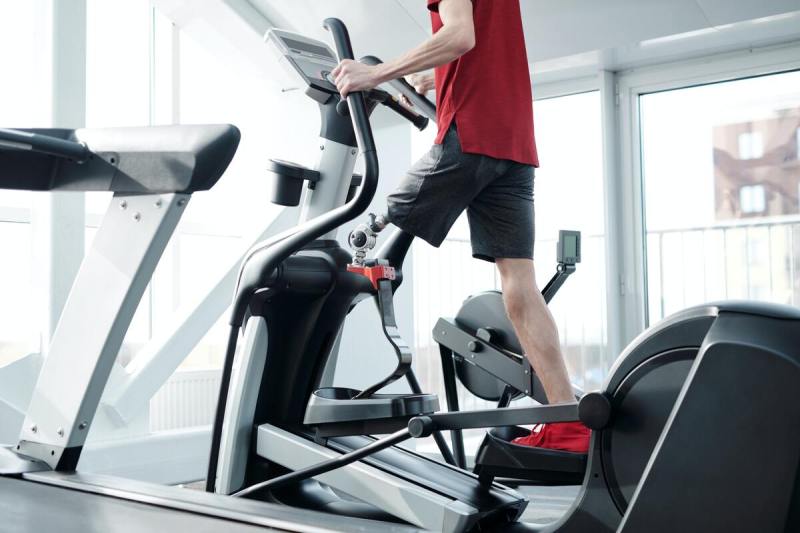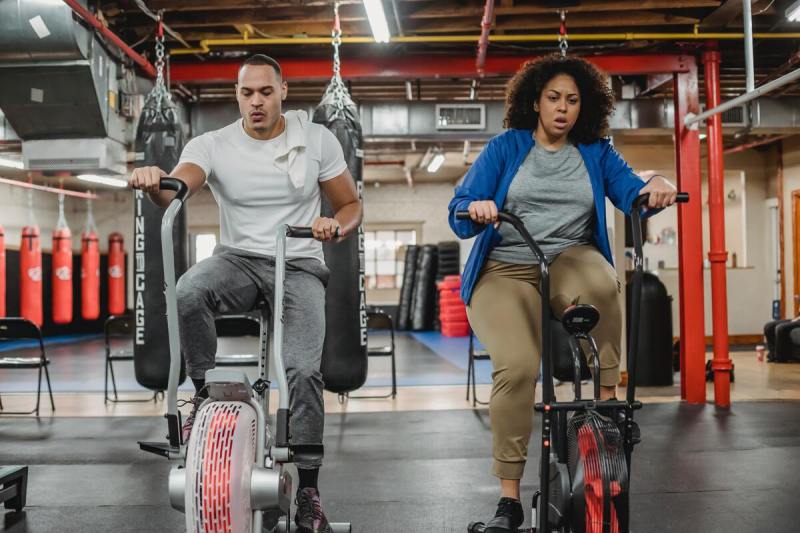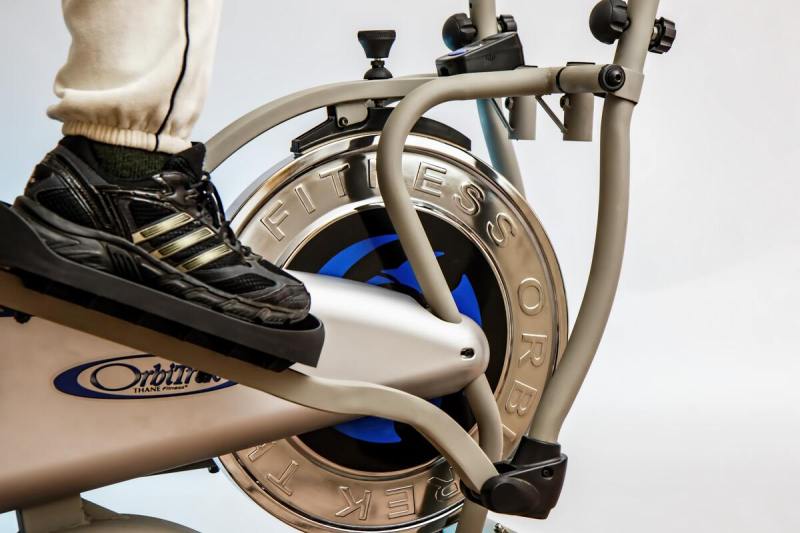Trying to decide between the elliptical and the stationary bike for your cardio workouts? Whether you’re aiming to lose weight, protect your joints, or build endurance, both machines offer impressive benefits—but which one is right for you?
As a trainer, I’m often asked which machine delivers the best results. The answer depends on your fitness level, goals, and personal preferences. In this guide, we’ll compare the elliptical vs. stationary bike across calories burned, joint impact, muscle engagement, and more—so you can choose the machine that fits your needs best.
Is an elliptical better exercise than a stationary bike?

Workout difficulty on either machine depends on intensity, resistance, and duration—not just the machine itself.
For example, when considering exercise bikes, pedaling at a moderate cadence with low resistance on a stationary bike is much less challenging than a high-intensity interval training (HIIT) workout on an indoor cycle or spin bike, where you’re coming out of the saddle and standing on the pedals for some intervals, and have your cadence and resistance dialed way up.
Similarly, you can do an easy workout on an elliptical machine by keeping the resistance low and moving at a walking cadence. On the other hand, using the incline, bumping up the resistance, and really getting your upper body involved can make for a vigorous workout.
In general, an exercise bike workout may be slightly easier than an elliptical workout since it uses fewer muscles and you’re in a weight-supported position on a bike seat. That said, give it your all in a spin class, and you’ll have your heart rate skyrocketing and your legs burning.
Here’s how the elliptical and stationary bike stack up side by side:
| Feature | Elliptical | Stationary Bike |
|---|---|---|
| Muscles Worked | Full body | Mostly lower body |
| Calorie Burn (30 min) | 270–378 (moderate) | 210–441 (moderate–vigorous) |
| Impact on Joints | Low impact, but weight-bearing | Low impact, non-weight-bearing |
| Adjustability | Limited stride/height options | More customizable |
| Cost Range | $500–$3,000 | $200–$1,000 |
| Space Needs | Bulky, needs power | More compact |
| Best For | Total-body, joint-friendly | Budget-friendly, knee issues |
What muscles does an elliptical work compared to a stationary bike?

In general, an elliptical provides a total-body workout, whereas an exercise bike is mostly just a lower-body workout. An elliptical machine works all the muscles in the lower body, as well as the core and arms, provided the machine has movable handrails. Increasing the incline of the ramp on the elliptical machine targets the calves, glutes, and hamstrings more.
Stationary bikes predominantly work the quads, hamstrings, calves, and even glutes (to a lesser extent). Spin bikes also strengthen the shoulders, core, and back to some degree, and standing on a spin bike turns it into a total-body exercise.
Which burns more calories, an elliptical or a stationary bike?

The number of calories you burn depends not only on whether you’re using an elliptical or stationary bike (or performing any other form of exercise, for that matter) but also on your weight and body composition and the duration and intensity of your workout. Therefore, it’s difficult to compare the calories burned on an elliptical versus an exercise bike.
However, Harvard Health Publishing reports that 30 minutes of “general elliptical use” burns 270 calories for a 125-pound person, 324 calories for a 155-pound person, and 378 calories for a 185-pound person, while moderate-intensity stationary biking burns about 210 calories for a 125-pound person, 252 calories for a 155-pound person, and 292 calories for a 185-pound person. This means that elliptical trainers may burn slightly more calories than stationary bikes.
However, it’s difficult to know what “general use” means in terms of intensity. Additionally, a 30-minute vigorous stationary bike workout burns approximately 315 calories for a 125-pound person, 378 calories for a 155-pound person, and 441 calories for a 185-pound person, which is more than the elliptical machine.
The best way to estimate your energy expenditure on either exercise machine is to use a heart rate monitor or fitness tracker and then use the formula for Metabolic Equivalents (METs).
Which cardio machine is better for weight loss?

Ellipticals and exercise bikes can both be used to reduce body fat and lose weight. The more calories you burn, the greater the caloric deficit you’ll generate, which then translates to weight loss, so burning calories on either piece of fitness equipment can get you closer to your body composition goals.
When considering the elliptical versus an exercise bike for weight loss, the winner mostly comes down to which workout you will do longer or more vigorously to burn more calories. For example, if you can push your body through hard or long indoor cycle workouts but only do moderate-intensity exercise or short stints on an elliptical, an exercise bike may result in more weight loss over time.
However, research shows that HIIT workouts are the most effective way to burn belly fat and encourage weight loss because they increase your metabolic rate even after your workout is over, so a HIIT workout on an elliptical or exercise bike will be better for fat-burning than a steady-state effort.
Additionally, increasing your lean body mass is also an effective way to lose body fat because muscle tissue is more metabolically active than fat tissue. So, crank up the resistance on an exercise bike or the incline on an elliptical machine to help build muscle.
Is an elliptical or stationary bike better for joint pain and knee health?

One of the shared benefits of elliptical machines and exercise bikes is that both are low-impact forms of cardio exercise. Compared to a high-impact activity like running on a treadmill, striding on an elliptical machine, or pedaling a stationary bike is gentler on your knees, hips, ankles, bones, and connective tissues. If you deal with chronic joint pain or arthritis, an elliptical machine or an exercise bike may be more comfortable than running or even walking.
That said, the stress on the body from each fitness machine is somewhat different. Stationary bikes are a weight-supported form of exercise because you’re sitting on the seat. In this way, you are non-weight bearing. This can be ideal for those with bone injuries or mobility issues and more severe knee pain. If you have balance issues, a recumbent bike can provide the back support and stability you need to feel safe and secure.
It can be difficult to get on and off elliptical machines, and some are quite high off the ground (step-up height). They also require more coordination and balance, so seniors or those with mobility impairments may feel safer on an exercise bike.
How adjustable are ellipticals vs. stationary bikes?

Elliptical machines may have different adjustment capabilities. Higher-end machines typically have an incline ramp and various resistance levels to make the workout harder. The user can also stride faster to increase the difficulty. However, most elliptical machines offer little to no size or height adjustments. There’s often one set of stride length and handle height, so if you’re quite tall or quite short, the machine may not fit you well.
Exercise bikes have seat height adjustments, handlebar height adjustments, and resistance adjustments. Some indoor cycles also offer additional adjustments like fore/aft adjustments of the seat and handlebars and a greater number of resistance levels. The rider can also increase the difficulty of an exercise bike by pedaling at a faster cadence (rpm).
Which is more budget-friendly: an elliptical or a stationary bike?

This one has a clear winner. When it comes to cost, exercise bikes are almost always less expensive than elliptical machines, especially when trying to match the quality between the two. In other words, your dollar will go much further towards buying a nice exercise bike than an elliptical. Spin bikes and upright stationary bikes cost anywhere from about $200 to $1,000, while elliptical machines usually cost about $500 to $3,000.
Inexpensive ellipticals are often poorly constructed and have a very short stride length — more like a step motion than a gliding stride. They may also have very limited resistance ranges and few, if any, programmed workouts.
How much space does each machine need in a home gym?

Elliptical machines are far larger and bulkier than most indoor cycles and stationary bikes. They also require power, whereas not all spin bikes do.
Is the elliptical or stationary bike more enjoyable to use?

Although it might be a stretch to strive to “love” your workout, exercise always feels easier if you enjoy what you do. Fortunately, you can now find both ellipticals and exercise bikes with smart technology and integrated tablets for streaming immersive workouts or entertainment. Some people are also drawn to exercise bikes as a way to train for outdoor cycling or triathlons, which provides greater investment in workouts.
However, the elliptical machine is a rather unique movement pattern that does not translate directly to any sport. Ultimately, however, enjoyment is a matter of personal preference, so try both and see which fitness machine you prefer.
How often should you use an elliptical or stationary bike?

This really depends on your personal lifestyle. It is generally recommended that you engage in cardiovascular activities for 150 minutes per week. That could mean 30 minutes a day, five days a week—doable for some, but overwhelming for others.
Figure out what makes sense for your schedule, and then make it happen. Staying consistent with two workouts per week is better than committing to four and then feeling disappointed when things come up, and you keep having to skip. Combine consistency with a healthy diet and plenty of sleep, and you will start to see results in no time.
Ultimately, both machines can help you reach your fitness goals. Whether you prioritize joint health, calorie burn, or space-saving, there’s no one-size-fits-all answer. The best choice is the one you’ll stick with. Let’s address a few quick questions to help you decide.
Frequently asked questions

Is 30 minutes of elliptical enough?
Yes, for many people, 30 minutes on the elliptical can be enough. Using the elliptical provides a low-impact, full-body cardio workout, burning calories and improving heart health. In fact, Michigan Medicine states that the elliptical can be a healthy choice because it “is easy on the joints, [and] it allows you to increase your resistance and keep an eye on your heart rate throughout your workout.”
What are the disadvantages of an elliptical?
The elliptical may not provide as intense a workout as running or cycling, limiting calorie burn and how much endurance you build. It also primarily targets lower-body muscles, offering less upper-body engagement. Additionally, it lacks the natural movement and variety of outdoor workouts, potentially feeling monotonous over time.
Both the elliptical and stationary bike offer effective cardio options, especially if you’re looking for low-impact exercise. Choose the one you’ll use consistently and enjoy most. Ready to invest in your health? Try both at your gym or local fitness store and see which suits you best.




